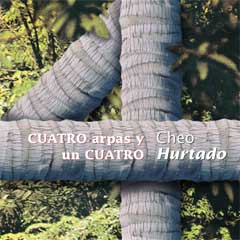Cuatro
arpas y un Cuatro
Cheo Hurtado
| CD 68.807 |
About Cuatro arpas y un Cuatro by Cheo Hurtado
 As children we heard Pedro Emilio Sanchez with his Seis por derecho with the
lines ending: " Juan played the cuatro / with unusual elegance / and all
that saw him/ remained with full admiration / this is the best cuatrista /
that come from our Llano".
As children we heard Pedro Emilio Sanchez with his Seis por derecho with the
lines ending: " Juan played the cuatro / with unusual elegance / and all
that saw him/ remained with full admiration / this is the best cuatrista /
that come from our Llano".
Half a century later at Angostura del Orinoco, Cheo Hurtado surprises us with a hummingbird in its hands, how it accompanies and directs a group of harp virtuosos. They play new versions of joropos from the Llanos, the purest and most representatives from our national songbook. Due to its outstanding high quality, this recording will be long time a high standard for the work and studies of numerous specialists of this music. The four harpists which communicate with the cuatro in this recorded journey throughout the Llanos of Venezuela are: Eudes Alvarez (1950, Guayabal, Guarico), José Archila (1970, Elorza, Apure), Alexis Ojeda (1968, San Rafael de Atamaica, Apure) and Carlo Orozco (1969, Barquisimeto, Lara)
"The song unfolds its blossom over the heart of the harp, " says Ernesto Luis Rodriguez. The singing becomes a flower and finds the best of all voices in the harpists to counterpoint the play of the cuatro..
The Indio Figueredo was the harp legend from former times, then came Juan Vicente Torrealba, which spread the music in its concerts. He was followed by a large number of outstanding interpreters leading to the young harpists from today The simplicity is what makes the success, says the vernacular. The beauty and purity of a song like El Gaban comes from only two elements: dominant chord and tonic. Or El pajarillo and El Seis por derecho with three elements in a repeated circle: quart, dominant chord and tonic.
But these joropos receive a completely new dimension in the hands from Cheo and its friends. Rural mixes with urban in the introductions, the intermediate plays, the jazzlike bassplay of the Chipola or simply in entire interaction. It may be that some folklore purists the foot nails will roll themselves up, but the musical development is inexorable, particularly if the final product is good.
We remember the lines of Alberto Arvelo Torrealba:
"What has the Cedar-wood of the Cuatro / so dry and nevertheless blooms floating? Is it the charm and the secret of our music or the familiar singing of Florentino? Is it the wisdom of the devil or the energy of a creative youth,which triumphed over its guidance? In the heart of Cheo the Cuatro transforms into a twig of savanna lilies. We enjoy the presence of the greatest folk musician of Venezuela of the our times."
On Cuatro Arpas y un Cuatro many working hours were spent, many rehearsals, at lot of inspiration and above all much love for the country. Last not least one should mention the Maracas of Layita and the different bassists which enriched the result.
The Celtic and Arab harps always lost themselves in old Europe. Their strings
vibrate today in the soul of Latin America, here they found a new homeland.
El Cuatro
The cuatro is a four-string small Iberian guitar, introduced into Venezuela during colonial times. It has relatives in the Brazilian Cavaquinho (from Portuguese Machete), Puerto Rico and Mexico, but sometimes the number of strings vary from 4 to 5 or to double-strings.
Cuatros are made of various kind of wood, while famous Cuatro constructor Miguel Angel Chirinos prefers Cedar wood. Their average size is 32 cm in length , 20 cm width and 13 cm height. They are made in three different sizes as: Cuatricos chiquitos, medios grandes and grandes. The strings are called bordón, tercera, primera and segunda, tuned in H-Fis-D-A and many other 'temples' according to specific uses. They are played in the punteo-style as well as in rasgueo or charrasqueo style, which corresponds to the ancient Spanish 'golpe' style. Another technique is the trémolo.
La arpa llanera
Soloists:
Eudes Alvazez (* 1950, Guayabal/Guárico)
José Archila ( *1970, Elorza/ Apure)
Alexis Ojeda (*1968, San Rafael de Atamaica/ Apure)
Carlos Orozco (*1969, Barquisimento/ Lara)
The harp played in the Llanos of Venezuela arrived there with the Spaniards in the 16th century- as an instrument developed from gothic or French harp used in Spain since 14th century. The Venezuelan harp consists in general of 32 strings, divided in registers of tiples (high). tenoretes (medium) and bordones (bass). Like all harps of that origin, it is diatonic.
The standard tuning tone A is on the thirteenth string. In contrast to the classic concert harp, which is equipped at a half-tone step with pedals for the increase or degradation of the tuning, half-tones are produced on the Venezuelan and other Latin American harps with the thumb at the string beginning at the corpus or tuned already beforehand according to the needs of the respective piece. The most usual tunings are D and G .
Iván Pérez Rossi
There's more detailed information about Llanos and the music in the CD-Booklet.
The press about Cheo Hurtado - Cuatro arpas y un Cuatro
Top of the World
Songlines
You won't find a better cuatro player, and each harpist is strong in his own right
Dirty Linen
The energy level on "Cuatro arpas y un cuatro" is as high as the quality of musicianship, and the joyous good spirits of this traditional Venezuelan music may leave you enervated, but content.
Rootsworld.com
More info on Cheo Hurtado
